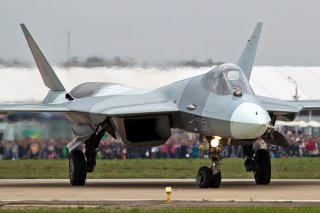Russia and India Had Big Plans to Build This Stealth Fighter. What Happened?
India buys lots of Russian military hardware. Why not stealth fighters as well?
In August of last year, Russia unveiled the export version of its fifth-generation Sukhoi Su-57 fighter aircraft. Displayed at the Army-2020 International Military and Technical Forum, the Su-57E also took part in the arms tradeshow's flight demonstration program.
Among the nations that apparently expressed interest in the aircraft was India, which The EurAsian Times reported was "seriously considering exploring an initial batch of 'off the shelf' Su-57 jets from Russia to evaluate their capabilities – before entering into a contract for joint production."
Oh the Irony
What is notable about that deal is that India had previously been a partner with Russia on the program, which was described as one of the most high-profile joint Indo-Russian defense projects before New Delhi pulled out in April 2018.
According to a story at the time published by The Diplomat, the Indian Air Force (IAF) has repeatedly stated its desire to withdraw from the program – when it was known as the Russian Sukhoi/HAL (Hindustan Aeronautics Limited) Fifth Generation Fighter Aircraft (FGFA) and in India as the Perspective Multi-role Fighter (PMF) – for some two years prior, and cited disagreements over cost-sharing plans, as well as technology transfer.
Additionally, the aircraft's technological capabilities were at issue, and that included Moscow's failure to develop a next-generation model. Instead, prototypes of the Sukhoi-57 were fitted with a derivative of the Russian-made Saturn AL-41F1S engine, which was designated the F1F1. It was an older aircraft engine that was already used on the Sukhoi Su-35S Flanker-E.
Why the Deal Died
One other breaking point in the deal was that the IAF had insisted on obtaining the capability to upgrade the multi-role fighter without Russian support, something that would have required Russia to share the so-called source codes. Moscow had rejected New Delhi's calls for such sharing of the sensitive computer codes, which are used to control the aircraft's various systems, but then reportedly agreed on the condition that India up its financial contribution to the joint program to $7 billion.
A little over a year after the initial break-up, Moscow sought to entice India back into the program, and in July 2019 Deputy Director of Russia’s Federal Service for Military and Technical Cooperation Vladimir Drozhzhov told reporters, "I believe that we should resume this project, Russia is open to that. We are ready and are proposing this program to our Indian partners."
However, in addition to the engines, the IAF had repeatedly criticized the aircraft's in-flight performance and expressed concerns that the Su-57 couldn't meet the low-observability requirements laid out by the service at the beginning of the joint defense project, The Diplomat also reported. The IAF had called for more than four changes that addressed the perceived weaknesses in the Su-57's engine, stealth and weapon-carrying capabilities.
Countering the IAF's claims, the Russian military has touted the capabilities of the fifth-generation fighter aircraft – highlighting its features including its stealth technology and board use of composite materials, as well as the plane's ability to reach supersonic cruising speed. The Su-57 is also noted for its advanced onboard radio-equipment, including a powerful onboard computer that has been described as a "second pilot."
The Su-57 also features a radar system that is spread across the entire body, while its armament is placed inside its fuselage. The multi-role fighter was designed to destroy all types of air, ground, and naval targets.
Peter Suciu is a Michigan-based writer who has contributed to more than four dozen magazines, newspapers and websites. He regularly writes about military small arms, and is the author of several books on military headgear including A Gallery of Military Headdress, which is available on Amazon.com.


